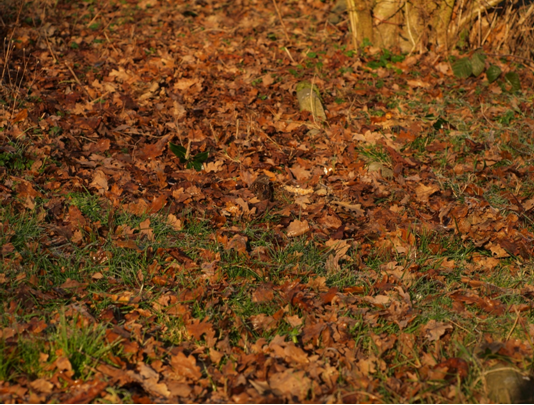However once the image is cropped a dunnock becomes visible:
However the image is more like a puzzle – where is the bird? – than an image to highlight the beauty of the bird. What is highlighted is the amazing ability for camouflage that our small birds have!
This session proved that the technique worked – several interesting birds visited, but the camera was too far away and the manual focusing poor. In addition bright sunlight would be needed to enhance the colouring of the birds.
On January 16th at 1230 I repeated the exercise, but positioned the camera closer to the food on the ground. Sunlight was coming from behind and to the right of the camera creating a speckled light in the area of the camera’s focus. The quality of the light was sufficient to allow the use of ISO 200 and a shutter speed of 1/100 second which would allow some capture of movement by the birds.
The settings for the camera were:
f/5.6; ISO 200; 1/100 second; focal length 102 mm
Below are some of the images produced:
The food can be clearly seen.
Although this image itself is somewhat dull, cropping of the image should help –
Cropping certainly improves the image. The bird becomes central, with its eye being at an intersection of the Rule of Thirds. Editing in Photoshop should provide further improvements.
The next image was taken an hour later at 1330:
This image of 2 pigeons can be cropped to highlight the bird on the left.
What a difference some sunshine on the subject makes. This image is perfectly focused with the eye looking straight at the camera. In addition the sunlight has highlighted the colours of the pigeon quite beautifully.
Pheasants also visited the feeding area:
This highlights two disadvantages of using a remote control system.
1. When the light changes you cannot alter the exposure setting.
2. Nor can you amend the focus - if the bird is only a few inches away from the focal point it can become badly out of focus.
The former I anticipated and ensured a setting where a reduction of light would produce under exposure - which can be corrected within Photoshop; rather than increased light producing overexposure - far more difficult to solve since over exposure literally 'bleaches' the colour away. i.e. I set the camera to slightly under expose
To solve the problem of birds being out of shot or out of focus I must experiment more with narrowing the area of feeding - although in truth the seeds were in a very small area. Patience and perseverance will be required. Possibly for pheasants corn seed in a container partially buried in the ground might prove beneficial.
Observation is another tool to use. I have noticed that the pheasants generally come to this area from East to West - the camera perhaps needs to be moved.
This area of photography within the garden has produced 2 successful images. I shall continue to pursue this scenario – probably in brighter sunlight to enhance the colouring of the birds and also to allow a fast shutter speed. Hopefully I will photograph the pheasants and partridges (in the summer the whole family visits!!), and also the smaller birds. To achieve a perfectly focussed shot of a shy wren would be most satisfying.
There are several areas in the garden where food on the ground can be used to entice the birds, sufficiently varied to enable the backgrounds of the photos not to become boring.
One area that I had not yet covered within my photography was that of ground feeders. This would include small birds such as finches and sparrows, blackbirds and thrushes, magpies and crows, pheasants and partridges, and finally squirrels.
All of these I had seen within the garden, but had been unable to take any photos. I decided that again the use of the camera on the tripod with the shutter being fired remotely was the best option. For this to be successful I needed to provide ‘bait’ – i.e. nuts and seeds on the ground in a situation suitably protected for the birds, yet sufficiently open to permit camera shots.
On January 2nd I placed nuts and seeds on the lawn quite near to the beech hedge, set up the camera and watched. Unfortunately no animals or birds came near the area – I think it was too open to be easily trusted by the birds. I moved the food to a nearby but more sheltered spot closer to shelter and continued to place food there over the next 2 weeks.
On January 15th, when the weather was bright and clear I placed more nuts on the ground in this area. The image area was quite large so that any feeding birds or squirrels could be in shot.
Below is a typical image – you might struggle to see the bird:
Below is a typical image – you might struggle to see the bird:







No comments:
Post a Comment